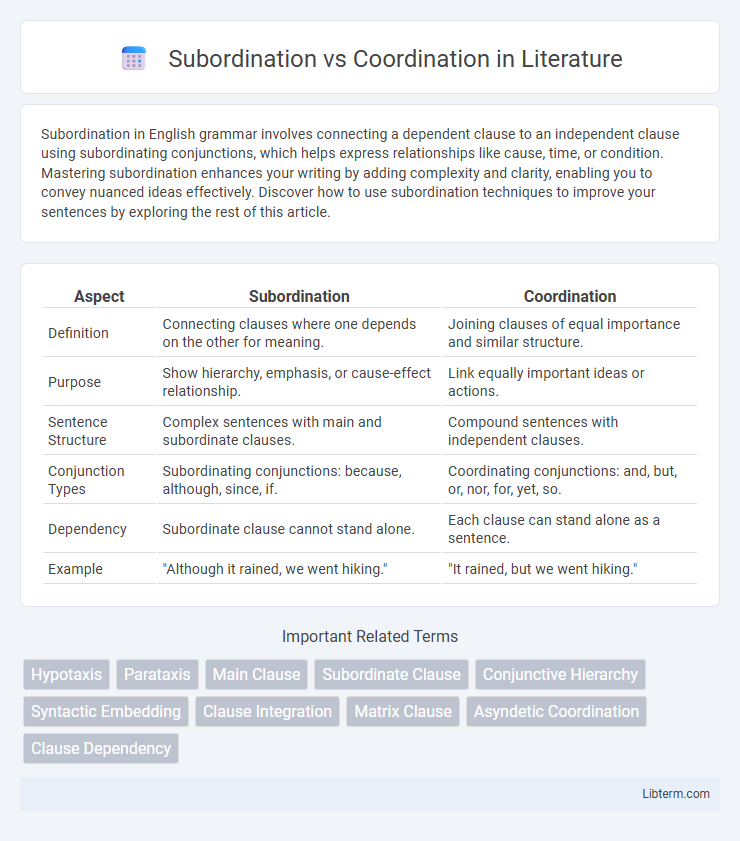Subordination in English grammar involves connecting a dependent clause to an independent clause using subordinating conjunctions, which helps express relationships like cause, time, or condition. Mastering subordination enhances your writing by adding complexity and clarity, enabling you to convey nuanced ideas effectively. Discover how to use subordination techniques to improve your sentences by exploring the rest of this article.
Table of Comparison
| Aspect | Subordination | Coordination |
|---|---|---|
| Definition | Connecting clauses where one depends on the other for meaning. | Joining clauses of equal importance and similar structure. |
| Purpose | Show hierarchy, emphasis, or cause-effect relationship. | Link equally important ideas or actions. |
| Sentence Structure | Complex sentences with main and subordinate clauses. | Compound sentences with independent clauses. |
| Conjunction Types | Subordinating conjunctions: because, although, since, if. | Coordinating conjunctions: and, but, or, nor, for, yet, so. |
| Dependency | Subordinate clause cannot stand alone. | Each clause can stand alone as a sentence. |
| Example | "Although it rained, we went hiking." | "It rained, but we went hiking." |
Understanding Subordination and Coordination
Subordination and coordination are fundamental syntactic relationships used to link clauses within sentences, enhancing clarity and complexity. Subordination establishes a hierarchical connection where a dependent clause relies on a main clause, exemplified by sentences like "Although it was raining, we went outside," showing logical dependence. Coordination links clauses of equal syntactic importance using coordinating conjunctions such as "and," "but," or "or," as in "She sings and he dances," maintaining parallel structure and balanced meaning.
Key Differences Between Subordination and Coordination
Subordination involves linking clauses where one depends on the other, creating a hierarchy with a main clause and a subordinate clause, while coordination connects clauses of equal importance using coordinating conjunctions like "and," "but," or "or." Subordination expresses relationships such as cause, time, or condition, exemplified by sentences like "She left because she was tired," whereas coordination simply combines independent clauses without indicating dependence. The key difference lies in the syntactic structure and semantic function: subordination creates complex sentences with embedded ideas, whereas coordination forms compound sentences by joining independent clauses.
The Role of Subordination in Sentence Structure
Subordination plays a crucial role in sentence structure by linking dependent clauses to independent ones, thereby creating complex sentences that convey detailed relationships between ideas. It establishes hierarchy within sentences, signaling that the subordinate clause provides essential background, reasons, conditions, or time frames related to the main clause. This hierarchical organization enhances clarity and precision in communication by showing how subordinate elements are subordinate in meaning and function to the core message.
The Importance of Coordination in Writing
Coordination is crucial in writing as it links ideas of equal importance, ensuring clarity and balance within sentences. By using coordinating conjunctions like "and," "but," or "or," writers create smooth transitions that enhance readability and prevent sentence fragmentation. Effective coordination helps maintain consistent flow, making complex information more comprehensible for readers.
When to Use Subordination for Clarity
Use subordination to emphasize the main idea by placing it in the independent clause while the less important information appears in the dependent clause. This structure clarifies relationships between ideas, showing cause, condition, or time, which helps readers understand the hierarchy of information. Subordination is ideal when one action depends on another, such as in complex sentences involving cause-effect or contrast.
Advantages of Coordination for Flow and Balance
Coordination enhances sentence flow by linking equal elements, creating a balanced and harmonious structure that is easier for readers to follow. It allows for clear, concise communication by joining independent clauses with coordinating conjunctions such as "and," "but," and "or," maintaining equal emphasis on each idea. This balance prevents sentence overload and improves readability, making complex information more accessible and coherent.
Common Subordinating Conjunctions Explained
Common subordinating conjunctions such as "because," "although," "since," and "while" introduce dependent clauses that provide essential context by showing relationships of cause, contrast, time, or condition. Subordination creates a hierarchy between clauses, where the subordinate clause relies on the main clause to complete its meaning, unlike coordination which connects clauses of equal independent status using conjunctions like "and," "but," or "or." Understanding these conjunctions is crucial for constructing complex sentences that clearly express logical relationships and nuanced ideas.
Effective Coordinating Conjunctions and Their Uses
Effective coordinating conjunctions such as "and," "but," "or," "nor," "for," "so," and "yet" link independent clauses to create balanced and clear sentences, enhancing readability and coherence. These conjunctions establish relationships of addition, contrast, choice, cause, or consequence, allowing writers to combine ideas without subordinating one clause to another. Mastery of coordinating conjunctions supports sentence variety and strengthens the logical flow in writing by equally emphasizing connected ideas.
Subordination vs Coordination: Common Errors
Subordination and coordination are often confused, leading to common grammatical errors such as comma splices and run-on sentences. Subordination correctly joins a dependent clause to an independent clause, clarifying relationships and avoiding sentence fragments. Coordination improperly connects clauses of unequal importance without appropriate conjunctions or punctuation, resulting in unclear or awkward sentence structure.
Tips for Balancing Subordination and Coordination in Writing
Balancing subordination and coordination in writing requires understanding their distinct roles: subordination emphasizes the relationship between the main and dependent clauses, while coordination links equally important ideas. Effective writing uses subordination to clarify cause, effect, or contrast, and coordination to present parallel or related information clearly. Aim for varied sentence structures, combining subordinated clauses for depth and coordinated clauses for rhythm and balance.
Subordination Infographic

 libterm.com
libterm.com